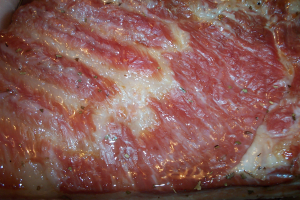Bacon!

For many people, bacon is the ne plus ultra of, well, food. There are bacon bandages, bacon candy, even bacon Martinis. Bacon nearly has a cult-object status.
The idea of curing my own bacon was one of the reasons I bought Michael Ruhlman and Brian Polcyn's Charcuterie. (Don't you love how this blog is almost, but not quite, a cook-everything-from-Charcuterie blog in the same vein as the Julie/Julia project or French Laundry at Home?) Not that I think commercial bacon is bad, but it just seems incredible to me that it's something you can make at home.
To do that, though, I needed two ingredients that you won't find at your local supermarket (unless your local supermarket is much better stocked than mine): pork belly and curing salt. The pork belly I was able to order from one of the butchers at the Guelph farmers market, and the curing salt from Stuffers Supply Co. in British Columbia.
Curing salt, also known as pink salt (because it is frequently, though not in my case, tinted pink to prevent confusion with regular salt), is a mix of table salt and sodium nitrite. The nitrite is the important part here: it's what keeps the meat pink and gives it its characteristic "cured" flavour, not to mention its longer shelf-life.
Setting up the bacon to cure is easy: just mix up the basic cure given in the book, add the suggested chopped garlic, bay leaves and black pepper for a "savoury" cure, dredge the belly, and put the whole mess in a big Ziploc bag for a week.
The hard part was knowing when it was done. The book says that you should check after 7 days, but that thicker bellies might need a little longer. And I was definitely working with a thicker belly - around 2.5 inches at the thickest point, which was almost exclusively fat. When the bacon is cured, it's supposed to feel "firm." But how firm is firm? By the time I decided to just move on to the next step (since I was leaving town the next day), it felt firmer than the raw product, but still slightly squishy.
Traditionally, bacon is smoked, but Ruhlman and Polcyn provide alternative instructions for those of us who haven't yet convinced our spouses of the necessity of buying a smoker. The alternative involves roasting the bacon in a very low oven until its internal temperature is 150 degrees Fahrenheit. They say this should take 2 hours, but I found it took closer to 5. This just goes to show my depth of commitment to the project: do you know what happens when you leave your oven on for 5 hours in the middle of summer? Yeah, me neither; I passed out from heat exhaustion around hour 3.
Once the bacon got up to temperature, I pulled it out of the oven, cut off a piece and ate it. It was really different from any bacon I've ever had before, partly because of the lack of smoke, partly because of the savoury cure, and partly because it actually tasted like meat rather than just salt. It's not the sort of bacon that I'd serve with eggs or pancakes (my next batch will definitely be a sweeter cure), but I have really enjoyed it in pasta (carbonara and amatriciana, so far) and look forward to using some in coq au vin or a frisée aux lardons.
All in all, I wasn't as completely blown away by it as some people (based on the blogs and eGullet post I've read), but I was quite pleased with it as a first effort. I may try and track down pork belly from a different source, since, with a preparation this fundamental, the quality of the raw materials makes all the difference in the world.

2 Comments:
At 10:36 PM, Unknown said…
Unknown said…
Nice. i actually am going to try this. I never thought about making my own bacon before. I am with you on the make everything from scratch thing, and I tend to make most everything I can from scratch. I would have to assume you like alton Brown because this stuff is all up his alley. He is where I once got the inspiration to make home made gyros...those rocked btw!
Athena Foods - Cook Like a Goddess
At 11:31 AM, Matthew said…
Matthew said…
Glad to know I've made another convert, George! It's truly worth trying: my second batch came out even better than the first. (And yes, I adore Alton Brown.)
Post a Comment
<< Home